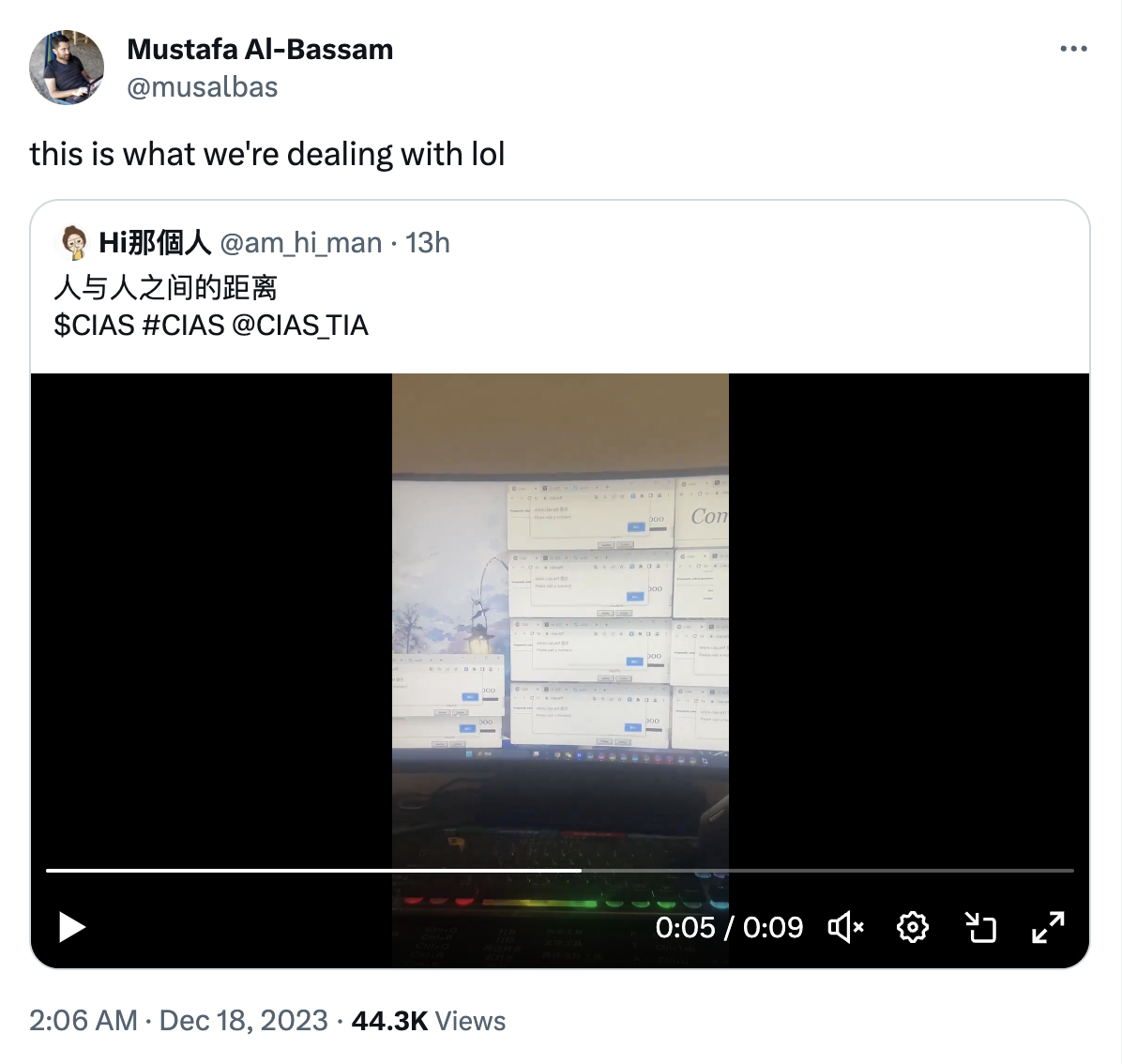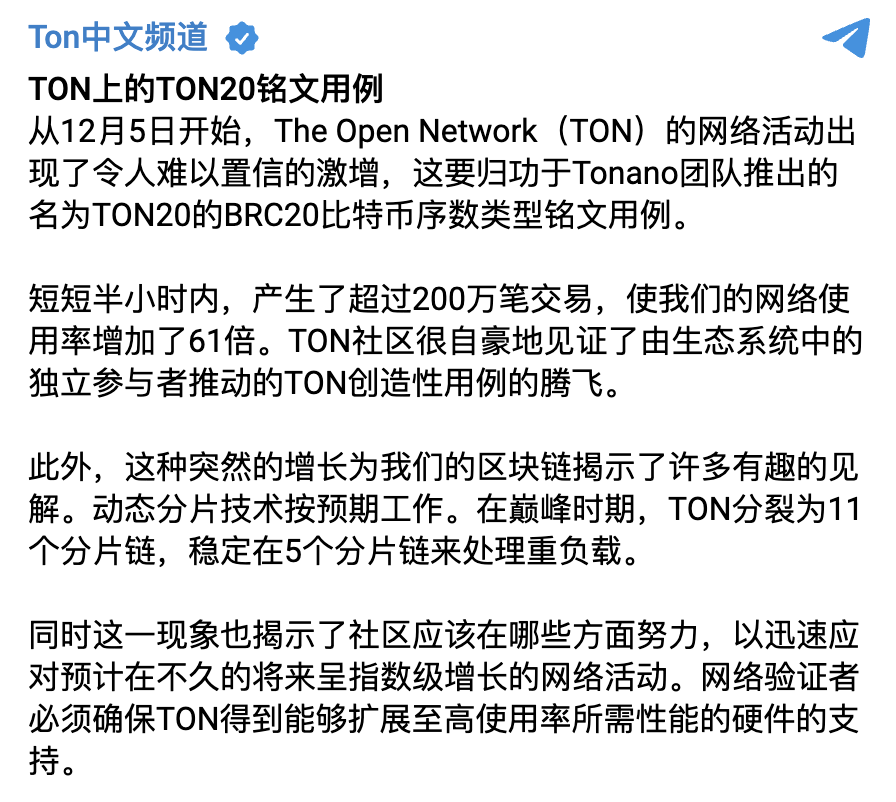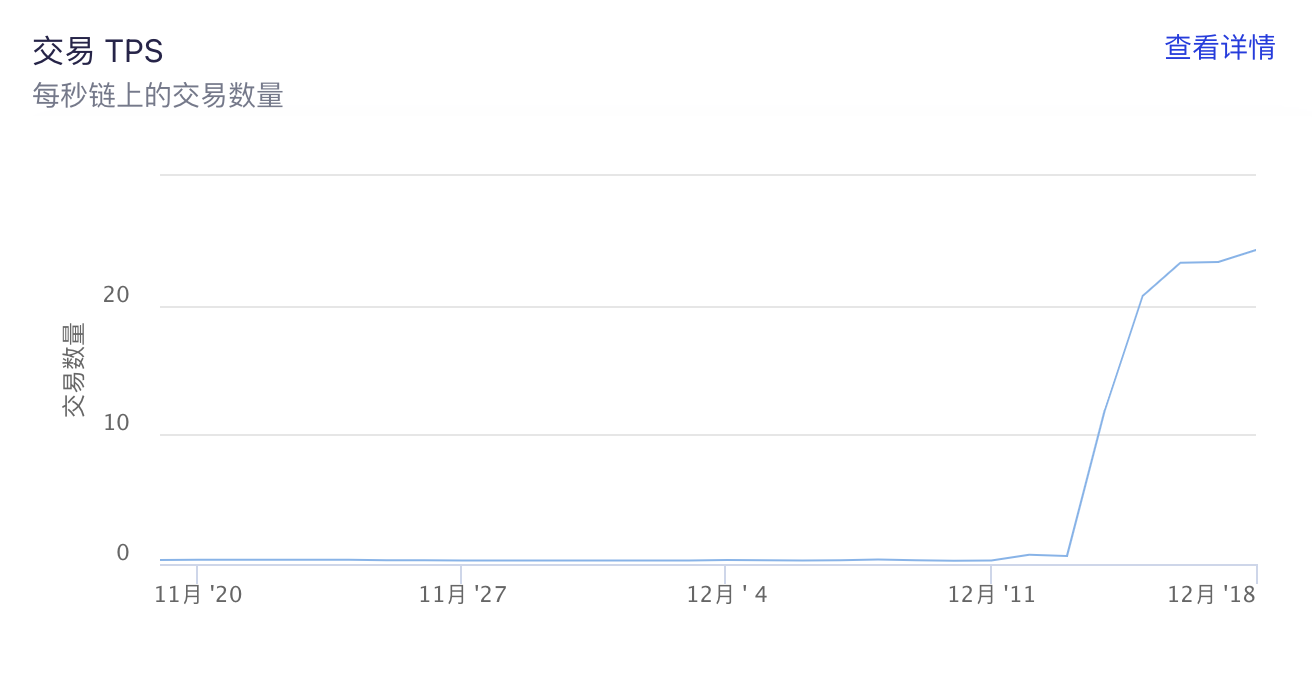Multiple public chains have been directly "crushed." How long can the inscription frenzy last?
Author: Kaori
This past weekend, the popularity of inscriptions only increased.
The first inscription project CIAS was launched on the modular blockchain Celestia, but the community discovered potential plagiarism of COSS inscription code by the CIAS project team. After CIAS officially opened minting, it received over 1 million visits from more than 120,000 people within an hour, with over 50% of transactions on the Celestia chain related to CIAS; subsequently, its team announced that the RPC encountered a failure, declared a pause on minting, and stated that they would notify the recovery time 12 hours in advance.
This sudden pause in minting was referred to by the community as "pulling the plug," but it did not diminish market attention towards CIAS. Someone posted a video of a scientist hitting CIAS in the community, and Celestia founder Mustafa retweeted the video, stating that this is a problem they need to solve.

Whether CIAS is an official inscription project launched by Celestia remains unknown, but it is evident that various public chains are also taking inscriptions seriously.
Stress Test "Inscriptions Edition"
In fact, the development of inscriptions has long transcended Bitcoin; it can even be said that inscriptions on different chains have become stress tests for those chains.
On December 8, after introducing the inscription protocol Tonado, which led to a surge in related activities, the TON network experienced prolonged transaction processing delays. According to monitoring data from the blockchain status bot dTON, starting from December 5, the Tonano team launched an inscription called TON20, which generated over 2 million transactions in just half an hour, increasing network usage by 61 times; this sudden peak traffic was accompanied by severe congestion on the TON network, even though network validators were still generating blocks, the verification was severely delayed.
As of the afternoon of December 7, over 2.5 million transactions were waiting to be processed, and the transaction processing speed on the TON blockchain dropped to less than 1 transaction per second, forcing the TON cryptocurrency wallets Wallet and Tonkeeper to suspend services.

TON inscriptions caused network congestion; Image source: TON Chinese official channel
Another public chain, Conflux, also experienced a similar stress test. According to ConfluxScan data, influenced by the wave of inscription activities, on December 15, Conflux reached a daily transaction count of 1.788 million, with CFX daily transactions hitting 100,000, both setting new highs for the year; the number of active accounts that day reached 17,700. Additionally, Conflux's daily transaction TPS exceeded 20 for the first time since early April 2021.

Conflux chain transaction TPS; Image source: ConfluxScan
The inscription projects on Avalanche also indirectly took on the role of stress testers. On December 18, @cryptofishx, co-founder of Avalanche's largest DEX Trader Joe, announced the launch of the asc-20 standard inscription (Avascription) BEEG, stating that this inscription has no roadmap and no practical use case, but is merely a social experiment.
It is reported that 37% of BEEG was minted within 2 hours and 15 minutes of its launch, with approximately 4,300 holders. @cryptofishx apologized for the actions that caused congestion on the Avalanche network and discussed solutions. According to Avascan data, during the minting process, the average Gas fee on the Avalanche network reached 5,110.30 nAVAX (approximately $4.41).

Avalanche network transaction fees; Image source: Avascan
In addition to various public chains, Ethereum L2 also showcased its capabilities in the inscription test.
On December 16, Arbitrum officials stated that the Arbitrum One sequencer stopped operating at 10:29 AM EST during a significant surge in network traffic. The official reason given was that the influx of users brought about by the inscription protocol caused the Arbitrum sequencer to stop working, ultimately leading to a network outage.
According to Arbiscan data, on December 15, the number of transactions on the Arbitrum chain surged to 4.39 million, setting a historical high; meanwhile, ultrasound money data showed that the Arbitrum L2 Sequencer Inbox contract destroyed the most ETH in the past 24 hours, reaching 795.7 ETH.
Following closely was another major Layer 2, zkSync. On December 17, during the minting of SYNC inscriptions, the zkSync network also experienced a brief "outage," with the blockchain explorer not displaying any blocks. Subsequently, the zkSync engineering director tweeted that despite achieving an unprecedented 150 TPS during the minting process, the network still fulfilled its responsibilities.

Crypto researcher HaoTian remarked that this was a good stress test experiment for zkSync, with the positive impact outweighing the negative, stating, "In the long run, the inscription event does not revert Layer 2 performance to its prototype; rather, it provides practical experience for further performance optimization of Layer 2."
Previously, it had become a consensus that centralized exchanges (CEX) were the main driving force behind the greater market volume for inscriptions, but now, the community jokingly says, "A chain that hasn't issued inscriptions is embarrassed to come out and mix," indicating that this power has shifted to public chains and L2. Compared to Bitcoin, new public chains and L2 have ample block space; they are not afraid of network congestion but rather fear a lack of active users and funds.
How Long Can the Madness Last?
On December 12, Binance co-founder He Yi stated during a Binance Chinese community AMA that the Binance Web3 wallet temporarily does not support inscriptions based on previous considerations of the inscription track. He believes that the nature of inscriptions is quite similar to NFTs, with periodic surges in popularity, but how they will develop after the hype is uncertain. Therefore, Binance may indeed not have invested enough in inscriptions. However, as a trading platform, it cannot decide products based on its own likes and dislikes; what is important for users should be met as much as possible. Currently, Binance is already "working overtime" on related tasks, and it will continue to iterate on what users need.
This gives inscriptions another space for imagination, and with more and more inscription projects emerging, this track has become one of the areas with the strongest wealth effect today. However, the accompanying sentiment is that "inscriptions have already reached a peak stage," and everyone is waiting for the next price pump to profit and exit.
Many people can't help but ask, "How long can the madness of inscriptions last?"
From the perspective of profit-taking, very few early players in inscriptions have remained in the game until now. Previously, crypto KOL RiYue XiaoChu wrote about a whale who made millions of dollars from ORDI in May and laid out SATS in July, profiting $36 million after it went live on Binance, achieving a significant leap in wealth. But such examples are merely a myth of wealth creation circulating in the community; most people here are just holding a few "turtle jelly" (the community's nickname for zero-value inscriptions) as they continue towards the next inscription.
However, from the infrastructure perspective, the future of inscriptions remains uncertain. Infrastructures and tokens for inscriptions on Bitcoin, such as MultiBit and BitStable, are still under construction. Although the recent wave of inscriptions on various public chains has reignited interest in this track, the lack of value discovery has made a group of crypto users, who are accustomed to DeFi emerging from nothing, realize that for inscriptions to achieve greatness again, more kindling is needed to fuel a bigger fire.
Now, inscriptions have reached the final madness phase of previous bull markets, where value is disregarded, and only hype is considered. Perhaps what matters is not how long inscriptions can survive, but how long you believe they can survive.









